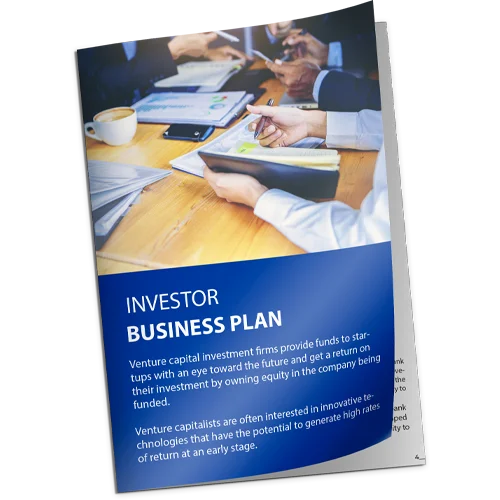
IN
RAISED
BUSINESS PLANS
INDUSTRIES
Investor Business Plan Writer
Investor business plans approach planning from the eyes of potential investors. These plans emphasize the expected return on investment (ROI), the strength of company leadership, the viability of the company’s concept and product or service offerings, and the expected use of funding. These plans prioritize easy access to information and get straight to the point. Here are some quick facts about investor business plans.
Investor Business Plans are Ideal For
- Investors, equity financing or partnerships
- Start-ups, seed or early-stage companies with a strong concept and or following
- Expanding businesses that can showcase their ROI upfront
- Established business owners looking to fund a new venture
What Our Investor Business Plan Includes
- Executive Summary
- Marketing Strategy
- Competitive Advantages
- Management & Personnel
- Investment Analysis
- Product & Service Description
- Company Overview
- Use of Funds
- SWOT Analysis
- Barriers to Entry
- Branding & Marketing
- Pro-Forma Financials
Why Choose Wise Business Plans
Expertise and Experience
Experienced business plan specialists for expert guidance and assistance.

Customized Approach
Tailored plans designed specifically for your unique business needs.

In-Depth Market Research
Thorough market research and analysis to provide valuable industry insights.

Financial Projections
Detailed financial projections and strategic guidance for optimal performance.

Proven Track Record
Successful funding and client outcomes.

Timely Delivery & Support
On-time delivery and ongoing assistance.
Real Client Feedback
Thoroughly and professionally done! I was very impressed with Eric, who patiently answered my questions and helped me understand the plan. And the graphic design on my final plan is wonderful! It's been a great experience. Highly recommend.
We sincerely appreciate all of your hard work. We have been VERY pleased with the services offered thus far and are extremely excited to take the next steps towards a finalized business plan! Thank you all SO much.
I am very thankful for the professional staff at Wisebusinessplans. My dream was brought to life in a full design business plan. I am now confident and excited to show my proposal to lenders or any one else who may be able to help me grow my business.
I really love the quality of services 'Wisebusinessplans' provides to their clients. I have nothing but great things to say about the company and their professionalism. This is going to help me grow my business in an amazing way.
The expert services that Wise Business Plans provided us helped our business increase in sales. Their workflow and processes were seamless and Wise are committed to our agreement and we are very satisfied. They are quick with a reasonable price.

4.9/5

4.7/5

5/5

4.8/5
Our Partners





Write your Investor business plan with a professional
Venture capital investment firms provide funds to startups with an eye toward the future and get a return on their investment by owning equity in the company being funded.
Venture capitalists are often interested in innovative technologies that have the potential to generate high rates of return at an early stage. A VC business plan will showcase the expected return on investment and the ways your company stands out for a long term.
Pro Tip: Here is a step by step guide on 5 best places to find venture capitalist.
What is an angel investor? Angel investors are usually successful entrepreneurs or wealthy business people who are willing to invest in a good business opportunity.
Angel investors have a more involved relationship with the companies they invest in, and they typically look to guide an entrepreneur who is building a company in a field the investor is familiar with.
An angel investor is likely to expect more personal interaction with your company leaders and may wish to develop something of a mentorship relationship with them. A business plan intended to create that kind of relationship with an angel investor will emphasize the company’s leadership and their connection to the industry.
How to find private investors business plan? Private investors are often found within a business owner’s personal creates a tautology circle of influence and can be anyone from family and friends to professional investors and speculators.
Treating these important business partners with the same level of respect and professionalism that you offer an outside investor is a just good business, and providing a business plan that shows exactly how their funds will be used, and what their return could be, can help create a solid working relationship, even with family and friends.
Regardless of the kind of investor, you hope to approach, asking someone to offer money in support of your vision is a big request. From high-profile investors to family members offering their savings to help you reach your dream, every potential investor deserves to understand the opportunities and risks involved with your company.
The Investor Business Plan offers potential investors an easy-to-follow and concise look at your company. The finished plan is typically about ~35-40 pages in length, including color charts and graphs, and consists of the following components:
You’ll receive a document written in Microsoft Word, financials custom-built in Microsoft Excel, and a finished plan laid out in professional graphic programs by skilled designers.
A Wise Business Pitch Deck helps direct investor attention to the points you most want to emphasize while offering a condensed pitch your presentation to potential funding sources. Each concise, visually appealing M&A Business Plan presentation for investors is carefully written and designed to support your investor business plan perfectly.
Investor plans are perfect for those seeking any kind of investment, from working with venture capitalists or angel investors to approaching friends and family. These plans make a clean, professional impression and base their appeal on hard facts, accurate numbers, and in-depth research and financials.
A lot of different kinds of decisions go into identifying and securing small business funding. Having the right kind of Investor business plan is one of the best things you can do to increase your chances of getting funded.
A Wise custom-crafted Investor Business Plan is tailor-made to showcase your vision. If you’re looking to raise capital through equity funding from venture capitalists (VCs), angel investors, or private investors, the Investor Business Plan from wise business plans is the right choice for you.
When most people begin the process of starting their own business, finding funds to make the dream a reality is one of the biggest things they’ll face.
A lot of different kinds of decisions go into identifying and securing small business funding or applying for a small business loan. Having the right kind of business plan for investors in your business model is one of the best things you can do to increase your chances of getting funded.
A Wise custom-crafted Investor Business Plan written to showcase your long-term concept, and if you’re looking to raise capital through equity funding from venture capitalists (VCs), angel investors, or private investors, You can hire wise business plans for writing a winning investor business plan. Why ? Because we are professionals who are providing investor business plan writing services in the USA.

FAQs
An investor-ready business plan is a strategic, professionally written document designed to attract equity funding by showcasing your business’s scalability, market potential, and financial upside. It includes a clear explanation of your pre-money and post-money valuation, equity offer, and anticipated return on investment (ROI). Whether you’re seeking capital from angel investors, venture capital firms, or private equity, Wise Business Plans ensures your plan communicates the value of your opportunity and how investors will profit.
To meet investor expectations and pass due diligence, a strong business plan should contain:
- Executive Summary with funding ask, valuation, and ownership offered
- Market problem and innovative solution
- Business model and monetization strategy
- Market size, TAM/SAM/SOM, and competitive landscape
- Financial projections (5 years) with EBITDA and cash flow
- Pre- and post-money valuations
- Use of funds
- Exit strategy with timeline and ROI multiples
Wise Business Plans incorporates these components to create a plan that not only informs but persuades.
A well-prepared business plan is essential for securing funding from:
- Angel investors – often interested in high-potential startups with clear pre-money valuations and upside
- Venture capitalists (VCs) – require strong growth potential, ROI projections, and defined exit pathways
- Private equity firms – focus on established businesses with a clear roadmap to scale or exit
- Family offices and high-net-worth individuals – expect a blend of financial rigor and vision
- Accelerators and incubators – need structured plans to assess viability and fundability
Each investor type has different risk tolerances, but all want to know how—and when—they’ll earn a return.
Investor plans focus on equity returns and long-term growth, whereas bank or SBA plans prioritize risk mitigation and loan repayment. Key differences include:
- Emphasis on pre- and post-money valuation
- Clear breakdown of use of funds tied to growth metrics
- Focus on ROI, including projected IRR or investor multiples (e.g., 5x return over 5 years)
- Inclusion of a defined exit strategy (acquisition, IPO, equity buyback)
- Attention to scalability, burn rate, and customer acquisition costs
Wise Business Plans crafts each plan based on its intended audience—ensuring alignment with what investors value most.
Wise Business Plans offers fully customized, professionally written investor-grade business plans backed by MBAs and financial analysts. Each plan includes:
- Market research specific to your industry
- 5 year financial modeling with pre- and post-money valuation estimates
- ROI calculations based on cash flows and projected exit events
- A compelling pitch narrative supported by facts
- Exit strategy mapping (e.g., M&A, IPO, or secondary sale)
Whether you’re raising a $250K angel round, a $2M Series A, or a $10M growth equity investment, our investor plans help you present a credible, compelling case that gets attention—and capital.
Get Started Today

- Business Planning
- Bank Business Plan
- Investor Business Plans
- Franchise Business Plan
- Strategic Business Plan
- M&A Business Plan
- Private Placement
- Feasibility Study
- Pitch Deck
- Pitch Deck
- Market Research
- Sample Business Plans
- Hire a Business Plan Writer
- Business Plan Printing
- Business Valuation Calculator
- Business Plan Examples
- Real Estate Business Plan
- Business Plan Template
- Business Plan Pricing Guide
- Nonprofit Business Plan
- Business Plan Makeover
- Business Funding
- Business E-learning Series
- Business Assets

Proud Sponsor of
- 1-800-496-1056

- (613) 800-0227

Quick Links


Business Planning
- Bank Business Plan
- Investor Business Plans
- Franchise Business Plan
- Strategic Business Plan
- M&A Business Plan
- Private Placement
- Feasibility Study
- Pitch Deck Business Plan
- Pitch Deck
- Market Research
- Sample Business Plans
- Hire a Business Plan Writer
- Business Plan Printing
- Business Valuation Calculator
- Business Plan Examples
- Real Estate Business Plan
- Business Plan Template
- Business Plan Pricing Guide
- Nonprofit Business Plan
- Business Plan Makeover
Business Funding
Business E-learning Series
Business Assets
Business Building
Compliance
Immigration Business Plans
Business Partners








